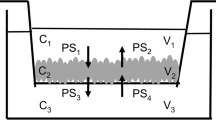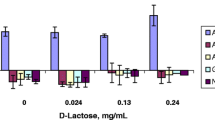Abstract
Purpose. Cell-based permeability screens are widely used to identify drug-P-glycoprotein (PGP) interaction in vitro. However, their reliability in predicting the impact of PGP on human drug pharmacokinetics is poorly defined. The aim was to determine whether a quantitative relationship exists between PGP-mediated alterations in Caco-2 permeability and oral pharmacokinetics in mice.
Methods. Two indicators of drug efflux were measured in Caco-2 for a group of 10 compounds, the ratio of A-B and B-A transport (RB-A/A-B) and the ratio of A-B transport in the presence and absence of a PGP inhibitor, GF120918 (RGF). These data were correlated with ratios of oral plasma levels in either mdr1a(-/-) or mdr1a/1b(-/-) and wild-type mice (RKO/WT in vivo) calculated from literature data on these compounds.
Results. A significant, positive correlation (r2= 0.8, p \h 0.01) was observed between RGF and RKO/WT in vivo. In contrast, RB-A/A-B, a more commonly used in vitro measure, showed a much weaker correlation with in vivo data (r2= 0.33, p = 0.11). A strong correlation with RGF was also observed after correction of in vivo data for PGP effects on IV clearance.
Conclusion. The increase in A-B drug permeability following inhibition of PGP in Caco-2 allows a reasonable prediction of the likely in vivo impact that PGP will have on plasma drug levels after oral administration.
Similar content being viewed by others
references
A. H. Schinkel and J. W. Jonker. Mammalian drug efflux transporters of the ATP binding cassette (ABC) family: an overview. Adv. Drug Deliv. Rev. 55:3–29 (2003).
A. Ayrton and P. Morgan. Role of transport proteins in drug absorption, distribution and excretion. Xenobiotica 31:469–497 (2001).
H. Kusuhara and Y. Sugiyama. Role of transporters in the tissue-selective distribution and elimination of drugs: transporters in the liver, small intestine, brain and kidney. J. Controlled Release 78:43–54 (2002).
J. H. Lin and M. Yamazaki. Role of P-glycoprotein in pharmacokinetics: clinical implications. Clin. Pharmacokinet. 42:59–98 (2003).
J. H. Lin. Drug-drug interaction mediated by inhibition and induction of P-glycoprotein. Adv. Drug Deliv. Rev. 55:53–81 (2003).
R. H. Stephens, C. A. O'Neill, A. Warhurst, G. L. Carlson, M. Rowland, and G. Warhurst. Kinetic profiling of P-glycoprotein-mediated drug efflux in rat and human intestinal epithelia. J. Pharmacol. Exp. Ther. 296:584–591 (2001).
A. Garrigues, J. Nugier, J. Orlowski, and E. Ezan. A high-throughput screening microplate test for the interaction of drugs with P-glycoprotein. Anal. Biochem. 305:106–114 (2002).
Y. Zhang, C. Bachmeier, and D. W. Miller. In vitro and in vivo models for assessing drug efflux transporter activity. Adv. Drug Deliv. Rev. 55:31–51 (2003).
J. H. Hochman, M. Yamazaki, T. Ohe, and J. H. Lin. Evaluation of drug interactions with P-glycoprotein in drug discovery: in vitro assessment of the potential for drug-drug interactions with P-glycoprotein. Curr. Drug Metab. 3:257–273 (2002).
J. W. Polli, S. A. Wring, J. E. Humphreys, L. Y. Huang, J. B. Morgan, L. O. Webster, and C. S. Serabjit-Singh. Rational use of in vitro P-glycoprotein assays in drug discovery. J. Pharmacol. Exp. Ther. 299:620–628 (2001).
A. H. Schinkel, U. Mayer, E. Wagenaar, C. A. A. M. Mol, L. van Deemter, J. J. M. Smit, M. A. van der Valk, A. C. Voordouw, H. Spits, O. van Tellingen, J. M. J. M. Zijlmans, W. E. Fibbe, and P. Borst. Normal viability and altered pharmacokinetics in mice lacking mdr1-type (drug-transporting) P-glycoproteins. Proc. Natl. Acad. Sci. USA 94:4028–4033 (1997).
C. P. Chen, X. R. Liu, and B. J. Smith. Utility of mdr1-gene deficient mice in assessing the impact of P-glycoprotein on pharmacokinetics and pharmacodynamics in drug discovery and development. Curr. Drug. Metab. 4:272–291 (2003).
R. H. Stephens, C. A. O'Neill, J. Bennett, M. Humphrey, B. Henry, M. Rowland, and G. Warhurst. Resolution of P-glycoprotein and non-P-glycoprotein effects on drug permeability using intestinal tissues from mdr1a(-/-) mice. Br. J. Pharmacol. 135:2038–2046 (2002).
Y. Adachi, H. Suzuki, and Y. Sugiyama. Comparative studies of in vitro methods for evaluating in vivo function of MDR1 P-glycoprotein. Pharm. Res. 18:1660–1668 (2001).
R. H. Stephens, C. A. O'Neill, A. Warhurst, G. L. Carlson, M. Rowland, and G. Warhurst. Kinetic profiling of P-glycoprotein-mediated drug efflux in rat and human intestinal epithelia. J. Pharmacol. Exp. Ther. 296:584–591 (2001).
U. I. Schwarz, G. K. Dresser, and R. B. Kim. MDR1 gene-dose effect in mice. Clin. Pharm. Ther. 69:P85(2001).
C. Dagenais, J. Zong, J. Ducharme, and G. M. Pollack. Effect of mdr1a P-glycoprotein gene disruption, gender, and substrate concentration on brain uptake of selected compounds. Pharm. Res. 18:957–963 (2001).
A. Sparreboom, J. vanAsperen, U. Mayer, A. H. Schinkel, J. W. Smit, D. K. F. Meijer, P. Borst, W. J. Nooijen, J. H. Beijnen, and O. vanTellingen. Limited oral bioavailability and active epithelial excretion of paclitaxel (Taxol) caused by P-glycoprotein in the intestine. Proc. Natl. Acad. Sci. USA 94:2031–2035 (1997).
U. Mayer, E. Wagenaar, J. H. Beijnen, J. W. Smit, D. K. F. Meijer, J. vanAsperen, P. Borst, and A. H. Schinkel. Substantial excretion of digoxin via the intestinal mucosa and prevention of long-term digoxin accumulation in the brain by the mdr1a P-glycoprotein. Brit. J. Pharm. 119:1038–1044 (1996).
R. B. Kim, W. F. Fromm, C. Wandel, B. Leake, A. J. J. Wood, D. M. Roden, and G. R. Wilkinson. The drug transporter P-glycoprotein limits oral absorption and brain entry of HIV-1 protease inhibitors. J. Clin. Invest. 101:289–294 (1998).
J. W. Jonker, J. W. Smit, R. F. Brinkhuis, M. Maliepaard, J. H. Beijnen, J. H. M. Schellens, and A. H. Schinkel. Role of breast cancer resistance protein in the bioavailability and fetal penetration of topotecan. J. Nat. Cancer Inst. 92:1651–1656 (2000).
U. I. Schwarz, G. K. Dresser, and R. B. Kim. Talinolol-verapamil interaction is not solely due to P-glycoprotein inhibition. Clin. Pharm. Ther. 69:P85-P85 (2001).
E. G. Schuetz, A. H. Schinkel, M. V. Relling, and J. D. Schuetz. P-glycoprotein: A major determinant of rifampicin-inducible expression of cytochrome P4503A in mice and humans. Proc. Natl. Acad. Sci. USA 93:4001–4005 (1996).
K. Beaumont, A. Harper, D. A. Smith and J. Bennett. The role of P-glycoprotein in determining the oral absorption and clearance of the NK2 antagonist, UK-224,671. Eur. J. Pharm. Sci. 12:41–50 (2000).
K. Yokogawa, M. Takahashi, I. Tamai, H. Konishi, M. Nomura, S. Moritani, K. Miyamoto, and A. Tsuji. P-glycoprotein-dependent disposition kinetics of tacrolimus: studies in mdr1a knockout mice. Pharm. Res. 16:1213–1218 (1999).
P. S. Burton, J. T. Goodwin, T. J. Vidmar, and B. M. Amore. Predicting drug absorption: how nature made it a difficult problem. J. Pharmacol. Exp. Ther. 303:889–895 (2002).
L. Z. Benet and C. L. Cummins. The drug efflux – metabolism alliance: biochemical aspects. Adv. Drug Del. Rev. 50:S3-S11 (2001).
R. H. Stephens, J. Tanianis-Hughes, N. B. Higgs, M. Humphrey, and G. Warhurst. Region dependent modulation of intestinal permeability by drug efflux transporters: in vitro studies in mdr1a (-/-) mouse intestine. J. Pharmacol. Exp. Ther. 303:1095–1101 (2002).
M. Lindell, M. Lang, and H. Lennernas. Expression of genes encoding for drug metabolising cytochrome P450 enzymes and P-glycoprotein in the rat small intestine; comparison to the liver. Eur. J. Drug Metab. Pharmacokinet 28:41–48 (2003).
E. G. Schuetz, D. R. Umbenhauer, K. Yasuda, C. Brimer, L. Nguyen, M. V. Relling, J. D. Schuetz, and A. H. Schinkel. Altered expression of hepatic cytochromes P-450 in mice deficient in one or more mdr1 genes. Molec. Pharm. 57:188–197 (2000).
M. D. Troutman and D. R. Thakker. Novel experimental parameters to quantify the modulation of absorptive and secretory transport of compounds by P-glycoprotein in cell culture models of intestinal epithelium. Pharm. Res. 20:1210–1224 (2003).
Y. Adachi, H. Suzuki, and Y. Sugiyama. Quantitative evaluation of the function of small intestinal P-glycoprotein: comparative studies between in situ and in vitro. Pharm. Res. 20:1163–1169 (2003).
Author information
Authors and Affiliations
Corresponding author
Rights and permissions
About this article
Cite this article
Collett, A., Tanianis-Hughes, J., Hallifax, D. et al. Predicting P-Glycoprotein Effects on Oral Absorption: Correlation of Transport in Caco-2 with Drug Pharmacokinetics in Wild-Type and mdr1a(-/-) Mice in Vivo . Pharm Res 21, 819–826 (2004). https://doi.org/10.1023/B:PHAM.0000026434.82855.69
Issue Date:
DOI: https://doi.org/10.1023/B:PHAM.0000026434.82855.69




